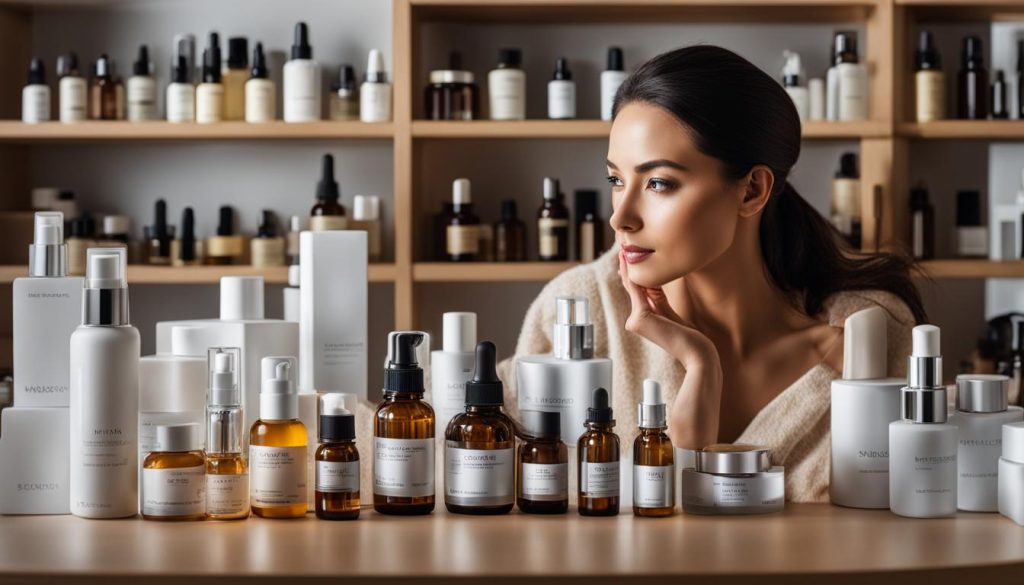Delving into the world of skincare, I’ve come to appreciate the transformative power of certain ingredients. Among them, hyaluronic acid stands out as a star player. With the capacity to hydrate and plump the skin, I’ve learned firsthand the wonders it does for maintaining a youthful glow. In this guide, you’ll discover practical steps on how to use hyaluronic acid effectively within your skincare routine, understand precisely when to apply hyaluronic acid, and explore the numerous hyaluronic acid benefits. Whether you’re skincare-savvy or just starting out, the versatility of hyaluronic acid for skin health is undoubtedly impressive, easily making it a cornerstone of any hyaluronic acid skincare routine.
How to Use Hyaluronic Acid
- Recognizing hyaluronic acid as a must-have for deep skin hydration and reduced fine lines.
- Understanding the ideal timing for applying hyaluronic acid to maximize its benefits.
- Exploring the synergistic effects of hyaluronic acid when combined with other skincare actives.
- Learning the significance of product formulation and skin compatibility in a hyaluronic acid regimen.
- Gaining insights on sustainable practices for incorporating hyaluronic acid into daily skincare.
Understanding Hyaluronic Acid and Its Role in Skincare
As a skincare aficionado, I’ve experienced firsthand the transformative impact of hyaluronic acid in my routine. This incredible substance isn’t just another trend; it’s a skincare stalwart with scientifically-backed benefits. Let’s delve into what hyaluronic acid actually is and how it functions as a powerhouse ingredient within your favorite products.

What is Hyaluronic Acid?
Often referred to as HA, hyaluronic acid is a naturally occurring biopolymer, which literally holds the key to smooth, flawless, and hydrated skin. Despite the name, it isn’t harsh or stripping—it’s the complete opposite! It’s a gentle substance that I’ve found to be crucial for maintaining my skin’s moisture levels, giving it that plump and hydrated look we all strive for.
The Power of Hyaluronic Acid as a Humectant
Here’s where the science gets truly fascinating and makes me appreciate high-quality hyaluronic acid products even more. HA is a master humectant, which means it binds moisture to the skin and keeps it there. This ability to attract and retain water is at the core of how hyaluronic acid works, transforming it from a mere ingredient to an essential component of any hydrating skincare product.
- Using a hyaluronic acid serum effectively can help in preventing the dehydration that results in premature wrinkles.
- A hyaluronic acid moisturizer doesn’t just sit on the surface of my skin— it penetrates and fills the gaps in my cells, leading to that highly sought-after dewy glow.
- The benefits of hyaluronic acid are manifold, ranging from instant hydration to long-term anti-aging effects.
Incorporating HA into my skincare routine has been a game-changer, especially knowing its capacity to work harmoniously with other products to keep my skin looking its best. Understanding how to use hyaluronic acid serum properly is like having a secret weapon for a radiant complexion.
How to Use Hyaluronic Acid for Maximum Hydration
Understanding how to apply hyaluronic acid correctly is pivotal to reaping its full moisture-binding benefits. My routine for achieving optimally hydrated skin involves a few critical steps that anchor around this powerful humectant. Let’s delve into the specifics.
Firstly, the question of when to use hyaluronic acid serum often arises in skincare discussions. I find that the best time to apply the serum is immediately after cleansing – morning or night. This ensures that my skin is free of impurities that might hinder the absorption of the acid.
As for how often to use hyaluronic acid, the good news is that it’s gentle enough for daily use. In fact, to maintain continuous hydration, I apply hyaluronic acid serum both in the morning and before bed. If you’re wondering, can you use hyaluronic acid every day, the answer is a definitive yes! Consistent use keeps my skin plump and well-hydrated throughout the ever-changing climates.
- Cleanse your skin thoroughly and leave it slightly damp.
- Apply a few drops of hyaluronic acid serum to your face and neck.
- Gently massage the serum onto the skin, allowing it to absorb fully.
- Seal the hydration with a nourishing moisturizer.
To avoid a common mistake, always remember this crucial tip: when do you apply hyaluronic acid, the skin should be damp. This key step ensures that the acid draws moisture from the environment rather than from deep within the skin, which can lead to dehydration.
With this simple yet effective framework, incorporating hyaluronic acid into your skincare ritual can provide long-lasting hydration, leaving your skin looking and feeling its best every day.
Selecting the Best Hyaluronic Acid Products for Your Skin
Embarking on the journey to find the best hyaluronic acid products tailored to your skin’s needs is pivotal for anyone seeking the illustrious promise of hydration and anti-aging benefits. With a market saturated with options, understanding the nuances of these products will elevate your skincare game to new heights.

Hyaluronic Acid Serums vs. Creams: Which is Right for You?
Standing before the vast array of skincare wonders, one may ponder – should I choose a hyaluronic acid serum or a cream? Serums, known for their potent formulations, often contain a variety of molecular sizes of HA that deliver not only surface-level hydration but also penetrate deeply to revitalize the skin’s lower layers. In contrast, hyaluronic acid moisturizers typically play the role of a sweep, retaining moisture and fortifying the skin’s barrier as an occlusive.
Ingredients That Enhance Hyaluronic Acid’s Efficacy
What truly sets apart a remarkable hyaluronic acid serum or cream is the symphony of supplementary ingredients that enhance its efficacy. Imagine the hydration powerhouse of HA paired with niacinamide’s skin-restoring attributes, the protective prowess of green tea antioxidants, or the age-defying magic of retinol. These are the partnerships that not only moisturize but also transform your skin’s health and vitality.
- Analyze label information to ensure a mix of different molecular weights of HA for comprehensive benefits.
- Favor serums with hyaluronic acid for anti-aging properties for a targeted approach, especially if fine lines and wrinkles are your main concern.
- Integrate hyaluronic acid moisturizers into your regime for an all-encompassing hydration strategy.
- Be keen on the interplay between HA and other ingredients to maximize the anti-aging and hydrating effects within your daily regimen.
As you refine your routine, make it a ritual to learn how to use hyaluronic acid serum in routine effectively, ensuring that every application is a step towards your goal of healthy, youthful skin.
Integrating Hyaluronic Acid into Your Daily Skincare Routine
As someone passionate about maintaining supple, hydrated skin, I’ve found that when to use hyaluronic acid is key to maximizing its benefits. To integrate hyaluronic acid effectively into my daily skincare regimen, my first step is cleansing, followed by applying any lighter serums. Then, comes the crucial moment: applying a hyaluronic acid serum while my skin is still slightly damp. This trick harnesses HA’s hydrating powers to their full extent.
Many of my readers ask, “Should I use hyaluronic acid in the morning or night?” The beauty of hyaluronic acid is its flexibility. I use hyaluronic acid serum in my routine both in the morning and at night to ensure that my skin receives consistent hydration. The decision of hyaluronic acid morning or night application should be based on personal preference and specific skin needs.
Another common question is, “How often should I use hyaluronic acid?” Here’s my answer: It varies depending on individual skin types and the formulations of the products I choose. But as a general rule of thumb, daily use is typically safe and beneficial, given that each product is fully absorbed before layering on additional skincare actives, like retinol or vitamin C.
- Cleanse your face to remove impurities and prep the skin.
- Apply any lighter serums that you use in your routine.
- While your skin is damp, apply the hyaluronic acid serum evenly.
- Allow the serum to absorb completely for optimal hydration.
- Follow up with a moisturizer to lock in the moisture and protect the skin barrier.
Integrating hyaluronic acid into your skincare routine isn’t complex, but attention to these small details can significantly impact its efficacy and your skin’s overall health.
Conclusion
In this comprehensive exploration of hyaluronic acid and its application within skincare, we’ve unveiled the profound impact this powerhouse ingredient can have on enhancing skin health. As we’ve discussed, the primary allure of hyaluronic acid is its unparalleled proficiency in hydration, which in turn significantly benefits the skin’s texture, elasticity, and overall resilience.
A Recap of Hyaluronic Acid Benefits
Hyaluronic acid’s capacity to hold up to 1,000 times its weight in water is nothing short of remarkable. This feature alone makes it a top pick for maintaining dewy, youthful skin. My experience aligns with the consensus that it effectively diminishes fine lines and imparts a supple, plump look to the skin. Undeniably, when used as directed, the benefits of hyaluronic acid for skin are abundant and can be enjoyed in various forms – as serums, creams, or even supplements. However, it’s crucial to consider the correct hyaluronic acid dosage and be aware of any potential hyaluronic acid side effects.
Final Tips for Hyaluronic Acid Usage
For optimal results, I tend to apply hyaluronic acid immediately after showering or cleansing my face when the skin is still damp, observing keenly when to put on hyaluronic acid to leverage its moisture-binding properties. It’s also imperative to remember that while hyaluronic acid injections provide more profound results, they should always be administered by healthcare professionals. And for those seeking additional support, hyaluronic acid supplements offer yet another avenue to bolster skin hydration. Keeping in mind these guidelines, together with personalized usage tailored to skin type and needs, hyaluronic acid can truly be your ally in achieving a radiant, healthy complexion.
FAQ
How do I use hyaluronic acid in my skincare routine?
To use hyaluronic acid effectively, apply it to clean, slightly damp skin, followed by a moisturizer to lock in hydration. Use it after any lighter-textured serums and before sunscreen in the morning or heavier creams at night.
What are the benefits of hyaluronic acid for the skin?
Hyaluronic acid benefits the skin by providing intense hydration, plumping fine lines, and making the skin appear more radiant. It also helps to strengthen the skin’s barrier, retain moisture, and improve overall skin texture and elasticity.
When is the best time to apply hyaluronic acid?
Hyaluronic acid can be applied both in the morning and at night. For best results, use it after cleansing and applying any lighter serums, on damp skin, to help lock in moisture.
Can I use hyaluronic acid every day?
Yes, hyaluronic acid is gentle enough to be used daily. It is a beneficial ingredient that can be incorporated into both morning and evening skincare routines.
Do I need to use moisturizer after applying a hyaluronic acid serum?
Yes, it’s essential to apply a moisturizer after a hyaluronic acid serum to seal in the hydrating benefits and ensure the skin remains moisturized.
How often should I use hyaluronic acid?
The frequency of hyaluronic acid use should be based on your skin’s hydration needs. Most forms of HA can be used twice daily, but always follow the recommendations on your specific product’s label.
Should I use hyaluronic acid in the morning or at night?
Hyaluronic acid is versatile and can be used both in the morning and at night. Incorporate it into your routine based on your personal skincare needs and preferences.
What type of hyaluronic acid product is best for my skin?
Select a product based on your skin type and concerns. Hyaluronic acid serums are suitable for targeted hydration and anti-aging benefits, while creams and moisturizers with HA provide broader moisturization. Look for products with a blend of molecule sizes for both deep and surface hydration.
Can I use hyaluronic acid with other ingredients like niacinamide or retinol?
Yes, hyaluronic acid pairs well with other skincare ingredients like niacinamide, retinol, and antioxidants. It enhances moisture retention when used in conjunction with these ingredients.
Are there any side effects to using hyaluronic acid?
Hyaluronic acid is generally well-tolerated and considered safe for most skin types. Rarely, some individuals may experience mild irritation. Always conduct a patch test before using a new product extensively.
What should I know about hyaluronic acid injections?
Hyaluronic acid injections, commonly used as dermal fillers, can add volume and smooth out wrinkles or folds. They should only be performed by a qualified healthcare provider, and you should discuss all potential risks and benefits before treatment.
Can taking hyaluronic acid supplements benefit my skin?
Hyaluronic acid supplements are claimed to support skin hydration and help reduce wrinkles from the inside out. However, it’s important to consult with a healthcare provider before starting any supplementation to ensure safety and appropriateness for your individual health needs.






